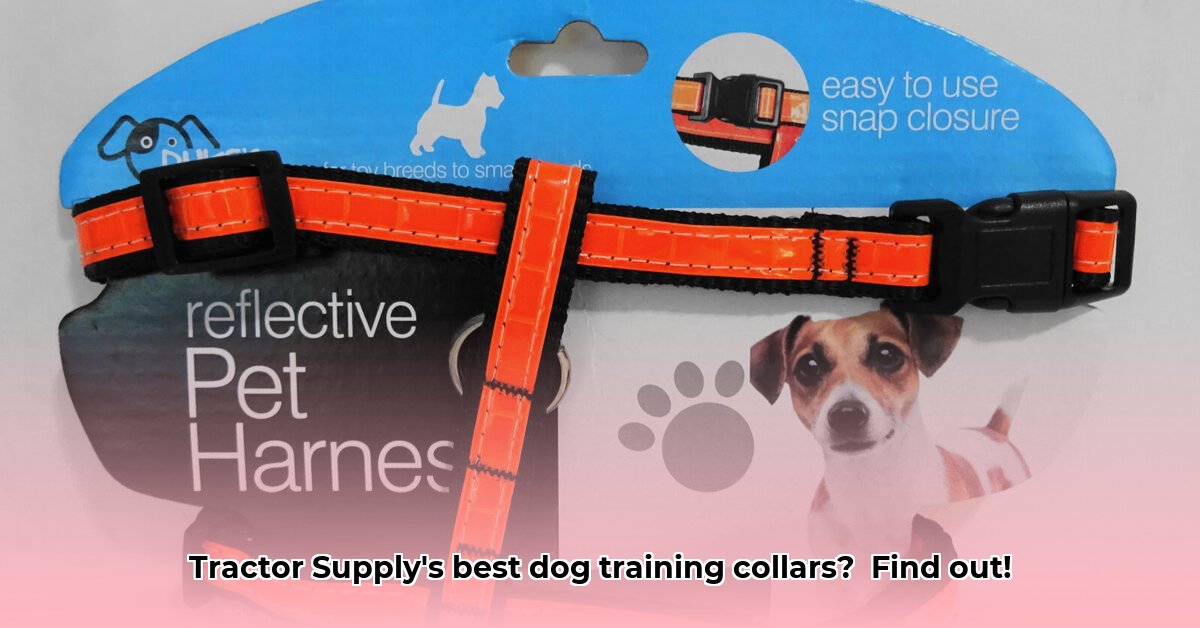
Choosing the right dog training collar can be overwhelming, especially with the variety available at Tractor Supply. This comprehensive guide helps you navigate the options, comparing different collars based on price, features, and user feedback. We'll explore the pros and cons of each type to find the perfect fit for your dog and your training style. For additional dog care resources, check out this helpful guide.
Understanding Different Dog Training Collars at Tractor Supply
Think of dog training collars as specialized tools. Each type serves a unique purpose, and choosing incorrectly can hinder your training progress. Let's explore the common types available at Tractor Supply:
Martingale Collars: A Humane Solution for Escape Artists
Martingale collars are ideal for dogs who are masters of escape. They gently tighten when your dog pulls, preventing escapes, but loosen when the pulling stops. This humane design prevents choking and is especially beneficial for breeds known for their wriggling abilities. They offer a balance between control and comfort.
Head Halters: Gentle Redirection for Leash Pullers
A head halter redirects your dog's head when they pull, discouraging the behavior without causing pain. This is a gentler approach than many other methods and is suitable for sensitive dogs or those with neck issues. It teaches your dog to walk calmly alongside you.
E-Collars (Electronic Collars): A Tool Requiring Careful Consideration
Electronic collars utilize various stimuli like mild electric shocks, vibrations, or tones to correct unwanted behaviors. Crucially, responsible and ethical use is paramount. These should never be used punitively. Many dog trainers recommend exploring positive reinforcement methods first, and seeking professional guidance before considering an e-collar. Always prioritize safety and consult a certified professional.
Basic Collars and Leashes: The Foundation of Good Dog Ownership
Never underestimate the importance of a properly fitted collar and leash! These provide the foundation for all dog training, from basic obedience to more complex commands.
Choosing the Right Collar for Your Dog
Selecting the perfect collar requires careful consideration of several factors:
Dog's Size and Breed: A collar must fit comfortably and safely. Too tight, and it's dangerous; too loose, and it's ineffective.
Training Goals: What behaviors are you targeting? Recall? Leash manners? Aggression? The goal determines the appropriate collar type.
Dog's Temperament: A sensitive dog needs a gentle approach; a stubborn dog might require more firm guidance (always humane).
Your Training Experience: Beginners may benefit from simpler collars and positive reinforcement techniques. Seeking professional help is crucial for complex scenarios.
Comparing Tractor Supply's Dog Training Collars
This table summarizes the key features of each collar type, aiding your selection process. Remember, specific details vary by brand and model.
| Collar Type | Ideal For | Advantages | Disadvantages |
|---|---|---|---|
| Martingale Collar | Escape artists | Safe, prevents escape, gentle correction | May not be ideal for all training scenarios |
| Head Halter | Leash pullers, gentle dogs | Gentle, redirects pulling, prevents neck strain | Requires proper fitting and understanding |
| E-Collar (Electronic) | Specific behavior problems (expert use only) | Can be effective for distance training; adjustable settings | Requires careful and responsible use; ethical concerns exist |
| Basic Collar & Leash | Foundation training | Simple, affordable, versatile | Limited training capabilities |
Tips for Success with Your Chosen Collar
Professional Guidance: A certified dog trainer provides personalized advice and effective training techniques.
Proper Fit: Ensure the collar fits comfortably, allowing two fingers to slide between the collar and your dog's neck.
Positive Reinforcement: Reward good behavior to create positive associations with the collar.
Safety First: Never leave your dog unsupervised while wearing a training collar, and monitor their reaction.
Remember, responsible dog ownership requires humane and effective training methods. The right collar is only one piece; patience, consistency, and positive reinforcement are essential for a well-behaved and happy dog.